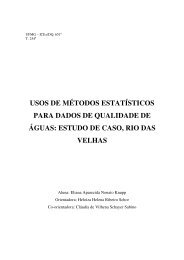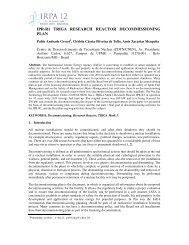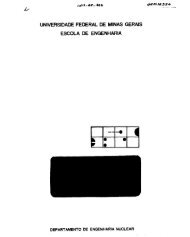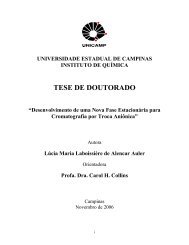thermocouples recovery of one triga instrumented fuel rod ... - CDTN
thermocouples recovery of one triga instrumented fuel rod ... - CDTN
thermocouples recovery of one triga instrumented fuel rod ... - CDTN
Create successful ePaper yourself
Turn your PDF publications into a flip-book with our unique Google optimized e-Paper software.
Fig. 4 . The <strong>thermocouples</strong> and extension cables after the breakdown<br />
3. Instrumented <strong>fuel</strong> burnup calculation results<br />
The results <strong>of</strong> the calculations for characterization <strong>of</strong> the nuclear and thermal parameters <strong>of</strong><br />
the <strong>instrumented</strong> <strong>fuel</strong> element after its withdrawal <strong>of</strong> the core are presented [5]. The<br />
neutronic analyses were performed by using the MCNP (Monte Carlo), ORIGEN and<br />
MONTEBURNS codes, considering the <strong>instrumented</strong> <strong>fuel</strong> in the core hottest position and a<br />
total burnup <strong>of</strong> 100.2 MWh. The simulations results are shown in the Table 1 and Table 2.<br />
The IF had a burnup <strong>of</strong> 0.2 g <strong>of</strong> 235 U (about 0.5%).<br />
The analysis <strong>of</strong> radioactive decay <strong>of</strong> the IF was so strongly conservative, because it was out<br />
all the decay occurred during the time that the IF was in the reactor core. The IF was almost<br />
3 years at the reactor core and only about 42 days <strong>of</strong> irradiation (reactor critical), all the time<br />
remaining was decay, which has been taken out in this analysis. The calculations show that<br />
after 1 year after the IF withdrawal <strong>of</strong> the core, the <strong>fuel</strong> activity was slightly higher than 1 Ci<br />
and the decay heat is less than 1 mW and the parameters <strong>of</strong> radiotoxicity by ingestion and<br />
inhalation are within the expected range.<br />
Tab. 1. Calculated results <strong>of</strong> <strong>instrumented</strong> <strong>fuel</strong> element burnup using the MONTEBURNS<br />
code [5]<br />
Decay after a<br />
235 U Activity Decay Radiotoxicity by Radiotoxicity<br />
burnup <strong>of</strong> 100.2 Mass*<br />
Heat Inhalation by Ingestion<br />
MWh<br />
(Ci)<br />
(month) (g)<br />
(mW)<br />
(m 3 <strong>of</strong> air) (m 3 <strong>of</strong> water)<br />
0 37.8 322.0 886 1.1 x 10 10 1.8 x 10 4<br />
3 37.8 1.7 0.9 1.1 x 10 10 1.8 x 10 4<br />
6 37.8 1.5 0.8 1.1 x 10 10 1.8 x 10 4<br />
9 37.8 1.3 0.7 1.1 x 10 10 1.7 x 10 4<br />
12 37.8 1.1 0.7 1.1 x 10 10 1.7 x 10 4<br />
* started with 38.0 g<br />
In all simulations to calculate the dose rates are disregarded any shield, except that provided<br />
by air at normal temperature and pressure. Two terms <strong>of</strong> radiation sources have been<br />
determined: the first using the term source code generated by the ORIGIN code and a<br />
second, more conservative, in which all the activity calculated for the IF was given the








